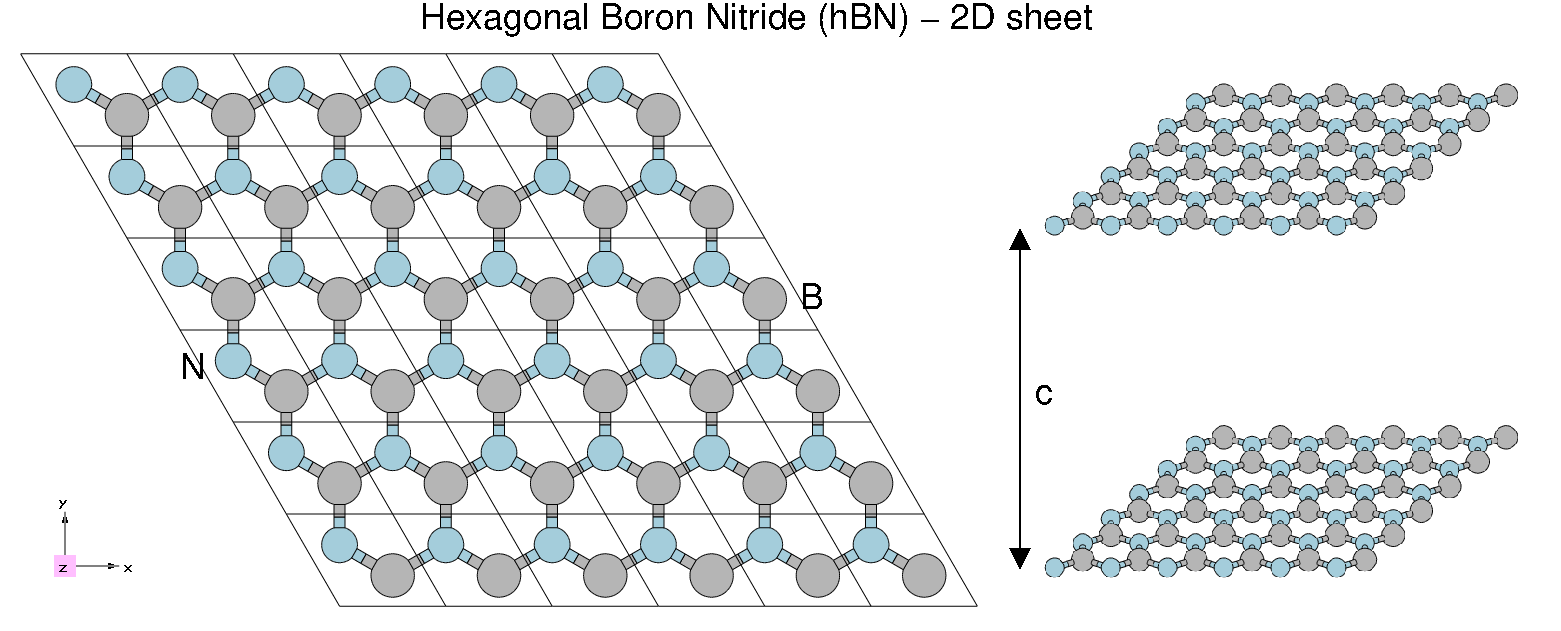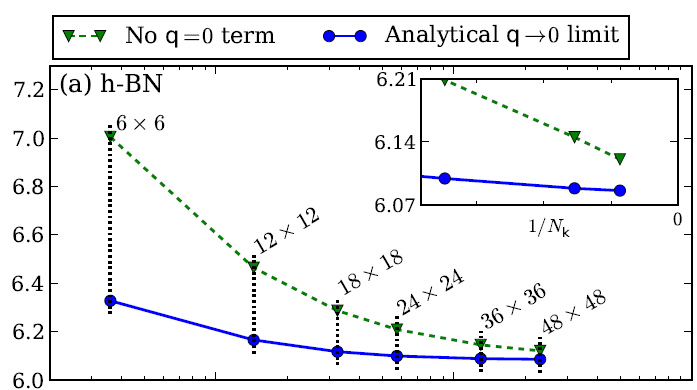Pushing convergence in parallel: Difference between revisions
(→2D hBN) |
|||
| Line 25: | Line 25: | ||
== Convergence on the number bands in X and G == | == Convergence on the number bands in X and G == | ||
To do convergence calculations you need to execute the same run many time, progressively changing one (or more of the input variables) | |||
We start considering the number of bands entering the construction of the response function. This will then be used to compute the screened electron-electron interaction, W, needed for the GW self-energy. | |||
% BndsRnXp | |||
1 | <span style="color: red">200</span> | # [Xp] Polarization function bands | |||
% | |||
Try to use different values, going to a very small one (say 10) up to the maximum allowed by the number of bands computed with pw.x to generate the present database (400). You may use 10, 25, 50, 100, 200, 400. | |||
Since now the focus is not anymore on the number of cores but on the yambo input parameters, it is a good idea to label the jobname accordingly to the latter in the run.sh script: | |||
label=Xnb${nbands}_Gnb200_ecut4Ry | |||
Then you can use the parse_qp.py script to extract the direct gap using the command | |||
./parse_qp.py $jobname/o-*.qp | ./parse_qp.py $jobname/o-*.qp | ||
| Line 40: | Line 48: | ||
200 4 6.717220000 | 200 4 6.717220000 | ||
400 4 6.733410000 | 400 4 6.733410000 | ||
Now you can try to do the same with the number of bands entering the definition of the green function | |||
% GbndRnge | |||
1 | <span style="color: red">200</span> | # [GW] G[W] bands range | |||
% | |||
You can do the same numbers we tried for the bands entering the response function. | |||
It is also a good idea to let yambo read the screening from a previous run. | |||
To this end you need to create a folder and copy there the screening DB | |||
$ mkdir SCREENING_400bands | |||
$ cp Xnb400_Gnb200_ecut4Ry/ndb.pp* SCREENING_400bands | |||
Then, to let yambo read it, edit the job.sh script creating the new variable | |||
auxjdir=SCREENING_400bands | |||
and | |||
srun -n $ncpu -c $nthreads $bindir/yambo -F $filein -J <span style="color: red">"</span>$jdir,<span style="color: red">$auxjdir"</span> -C $cdir | |||
tips: <br> | |||
- | |||
- remember to run in parallel, we suggest you keep using 16 cores, with 2 OpenMP threads, but for the biggest runs you can try to use even more than one node | |||
== Convergence with the energy cut-off on the response function == | == Convergence with the energy cut-off on the response function == | ||
Revision as of 08:00, 26 April 2017
2D hBN
In the previous session we focused on the scaling properties of the code. We now focus more on the physical aspect.
The system we are working on is the 2D-hBN sheet we already used the first day.
If you want a published reference of quasi-particle properties of hBN you can have a look to the following arxiv, https://arxiv.org/abs/1511.00129 (Phys. Rev. B 94, 155406 (2016)), and references therein, were the GW correction are computed. In that case the convergence with the number of k-points is studied in detail (for hBN and other materials). The focus is on a proper description of the q->0 limit of the (screened) electron-electron interaction entering the GW self-energy. As you can see from the below image extracted from the arxiv the QP corrections converge slowly with the number of k-points.
In the present tutorial you will start using a 12x12 grid. Only in the last part we will re-run pw.x (optional) to generate bigger k-grids
Tomorrow you will learn how to do that in a more automatic way using the yambopy scripting tools, however running yambo in serial. While yambopy offers an easier interface for the use, in the present parallel tutorial you will be able to push much more the convergence. In a real life calculation you will likely take advantage of both.
Convergence on the number bands in X and G
To do convergence calculations you need to execute the same run many time, progressively changing one (or more of the input variables) We start considering the number of bands entering the construction of the response function. This will then be used to compute the screened electron-electron interaction, W, needed for the GW self-energy.
% BndsRnXp
1 | 200 | # [Xp] Polarization function bands
%
Try to use different values, going to a very small one (say 10) up to the maximum allowed by the number of bands computed with pw.x to generate the present database (400). You may use 10, 25, 50, 100, 200, 400. Since now the focus is not anymore on the number of cores but on the yambo input parameters, it is a good idea to label the jobname accordingly to the latter in the run.sh script:
label=Xnb${nbands}_Gnb200_ecut4Ry
Then you can use the parse_qp.py script to extract the direct gap using the command
./parse_qp.py $jobname/o-*.qp
The output should be something similar to
#nbnd ibndval Egap [eV] 25 4 6.848440000 50 4 6.759580000 75 4 6.724210000 100 4 6.712120000 200 4 6.717220000 400 4 6.733410000
Now you can try to do the same with the number of bands entering the definition of the green function
% GbndRnge
1 | 200 | # [GW] G[W] bands range
%
You can do the same numbers we tried for the bands entering the response function. It is also a good idea to let yambo read the screening from a previous run. To this end you need to create a folder and copy there the screening DB
$ mkdir SCREENING_400bands $ cp Xnb400_Gnb200_ecut4Ry/ndb.pp* SCREENING_400bands
Then, to let yambo read it, edit the job.sh script creating the new variable
auxjdir=SCREENING_400bands
and
srun -n $ncpu -c $nthreads $bindir/yambo -F $filein -J "$jdir,$auxjdir" -C $cdir
tips:
-
- remember to run in parallel, we suggest you keep using 16 cores, with 2 OpenMP threads, but for the biggest runs you can try to use even more than one node
Convergence with the energy cut-off on the response function
Convergence with the number of k-points (optional)
| Prev: Tutorials Home | Now: Tutorials Home --> GW Convergence | Next: Parallel tutorials are over |

